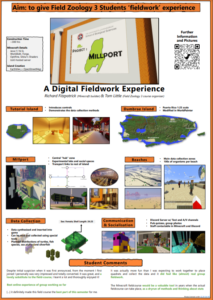Project Millport came out of discussions in September 2020 on whether Minecraft might be adapted to create a virtual fieldwork experience. The aim was to offer students on the Field Zoology 3 course at the University of Edinburgh a chance to work together and collect data themselves from a range of different locations, therefore providing a flavour of real fieldwork in a virtual setting.
Students normally spend just under a week collecting data on the various flora and fauna on the beaches of Great Cumbrae, of the west coast of Scotland. Project Millport (the name an homage to the island’s town), similarly asked students to spend five days in-game collecting data from the island of Dumbrae. The island was designed to have four beaches, a central “hub” zone, and a tutorial area. The latter gave everyone a chance to get used to the controls, and the specific game mechanics introduced by Richard.
The central zone consists of a transport station, an Eco-lab, library, gardens, and two recreations of Millport establishments (the Newton pub and Ritz café). The Eco-lab offered the opportunity for students to conduct food preference tasks on aquatic and land-based animals. The library links to videos and the main course page through QR codes. The station, where all users start, offers rail and instantaneous transport to the beaches, maps of each one, and a tool collection point. The tools are customised in-game items which allow students to lay down quadrats and transects, tag animals, and extract data (sex, shell length, and width) from the island’s turtle population. Each beach is designed to have a specific distribution of turtles, tropical fish species, coral, silverfish, and sea pickles, the data generated by Tom. The beaches gradually rise above sea level, and offer their own unique geographical properties which the students could add into their project hypotheses.
Project themes were provided as suggestions for students, who in their groups could choose their own project ideas and check these with staff during the field trip. The key reasons this virtual fieldwork succeeded lay in the multiplayer Minecraft server, and accompanying Discord server. The former allowed group members to see each other in-game, collecting data in real-time collaboratively, and allowed staff to troubleshoot problems speedily (which were largely rescuing people from falling down holes!). The Discord server offered a space where student groups could communicate semi-privately in text and audio-visual channels. A general channel allowed staff to give announcements, and students could ask staff to drop into their audio channels for advice and help when needed.
The mix of immediate feedback from the game-based learning approach, and the ability to synchronously communicate with peers and staff for the duration of the field trip, co-created the successful capturing of the “spirit” of normal fieldwork. Student comments in a follow up survey (some of which is in the poster), point to the combination being the crucial element. This suggests that the approach may have benefits even beyond the pandemic, allowing students a pre-field trip exercise, or being adapted to suit the needs of other students at other institutions or in situations where travelling to the field may provide impossible for some students.
For more specific questions on the mechanics of building the experience, and using Minecraft generally as an immersive learning tool, contact Richard (rfitzpa2@ed.ac.uk). For the experience as a course organiser, and the meeting of learning outcomes, contact Tom (tom.little@ed.ac.uk).

